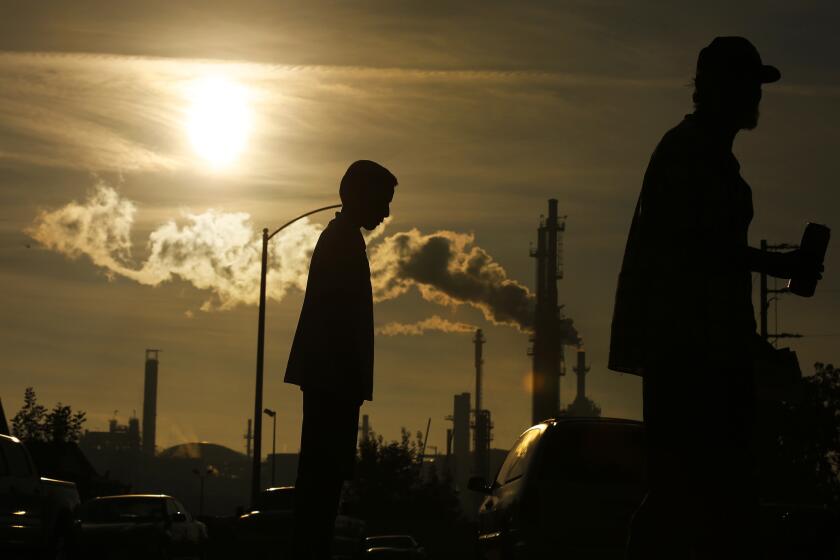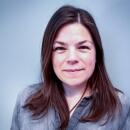
- Share via
PORTLAND, Ore. — It had been a long day and Daniela Molnar’s mind was wandering when she saw the shape. The shape of what was already lost; the shape of something new that had just come into being.
Little did she know, it was a shape that would expose a profound feeling of grief within her — and then help her process it.
In literal terms, the shape was made up of missing chunks of the Eliot Glacier on Mt. Hood that had melted away because of climate change, exposing land that hadn’t seen sunlight in hundreds of years. It flickered onto a projector screen during a lecture by a hydrologist that Molnar had started to tune out.
“I haven’t seen that shape before,” thought Molnar, an artist and professor at the Pacific Northwest College of Art. “Maybe I can use that.”
At home in Portland, Molnar projected the image onto her canvas, revealing the ghostly husk of a mountain. Then she began to paint it using crushed rocks mixed with gum arabic—a binder—and water from the rain barrel in her yard.
Her goal, initially, was to draw attention to climate change and give shape to an often-abstract issue.
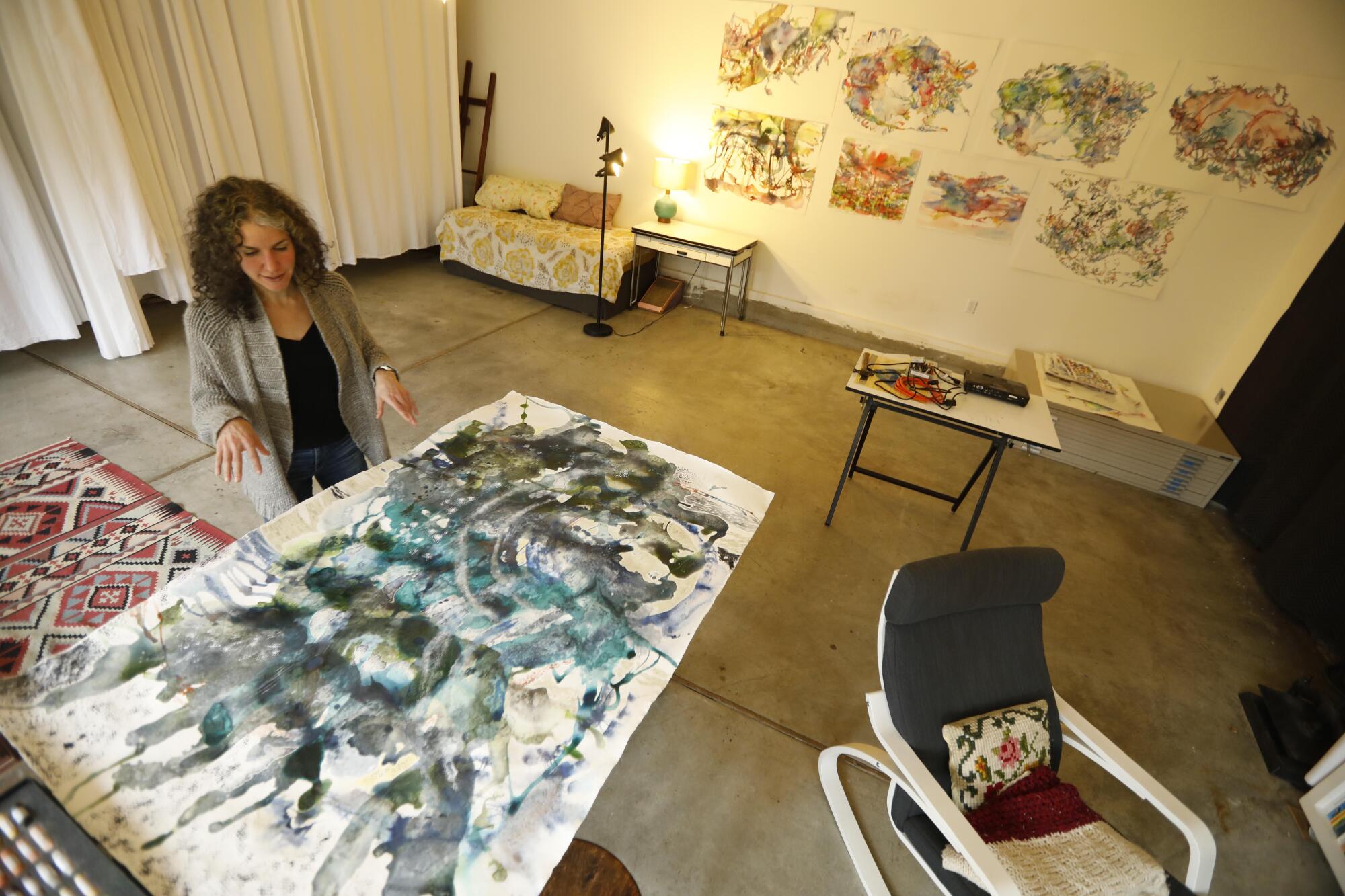
“Here, look at this, you can see it now,” Molnar remembered thinking. “And you can see it in an artistic form that might provoke some feeling.”
Then, Molnar’s own feelings began to take over.
On an impulse, she painted the outlines of other diminished North American glaciers over the first, the geometries and hues piling up like scraps of tulle.
“I didn’t know where this was going,” Molnar recalled. The work grew more chaotic and the shapes, in their jaggedness, faintly violent. She too grew more overwhelmed and confused.
After Molnar had created more paintings of vanishing ice, it hit her: this is what it feels like to try to hold the enormous losses brought about by climate change.
Global warming is transforming Earth’s landscapes and ecosystems, swelling the seas and driving many species closer to extinction. It has already contributed to natural disasters, famines and wars. Even if you accept that humans are to blame, it can be hard to absorb the full weight of such unpleasant facts. But what if that’s the problem?
What if acting on climate change requires that we first let ourselves feel its true costs? Molnar was about to find out.
The studio where Molnar made the paintings is a small shed nestled among nodding hellebores in the backyard of her house in a quiet Portland neighborhood. It has a Scandinavian feel, with succulents in the windows, bare cork floors, and stacks of books everywhere, including a volume about historical tragedies called “Against Forgetting: 20th Century Poetry of Witness.”
Many artists, including Molnar, are now bearing witness to the changes unfolding in the 21st century.
Some have created overtly political works that evoke outrage or guilt, like a sculpture that was displayed in Paris during the 2015 United Nations climate talks: a polar bear impaled on an oil pipe.
Others pay homage to the beauty of the world, like Zaria Forman, who paints stunning hyper-realistic images of ice using her fingertips instead of brushes.
“The welter of emotions that people feel about the climate crisis, they can see in the mirror of art,” said Miranda Massie, director of the Climate Museum in New York City.
At first glance, it’s not clear what Molnar’s works are about.
She paints with translucent, often iridescent pigments that morph from yellow to green, teal to indigo, purple back to red. The shapes are vibrant and beautiful — culled from scientific studies and satellite images — and they cover the canvas in a colorful confetti of ruin.
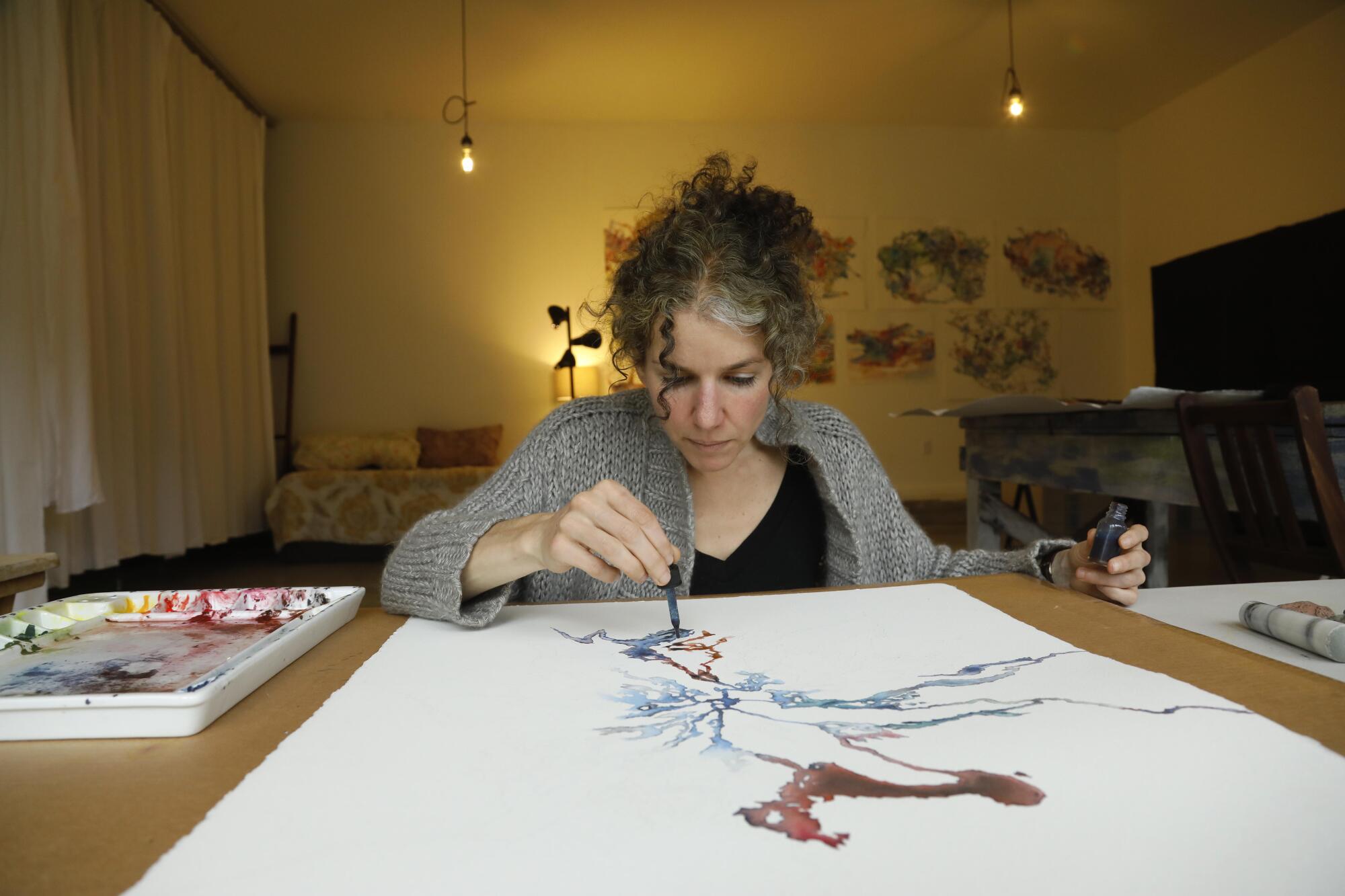
But despite the paintings’ cheery palette, they give Molnar — and viewers — an opportunity to engage with the staggering scope and interconnectivity of climate change.
“You can’t extract one piece of receding glacier from another,” Molnar said.
To aid her audience, a brief description accompanies each piece, explaining that the shapes represent pieces of land where ice has melted away. Molnar adds that “this new earth is like a wound, or new, delicate skin that has formed over a wound and is now (ready or not) exposed to the world.”
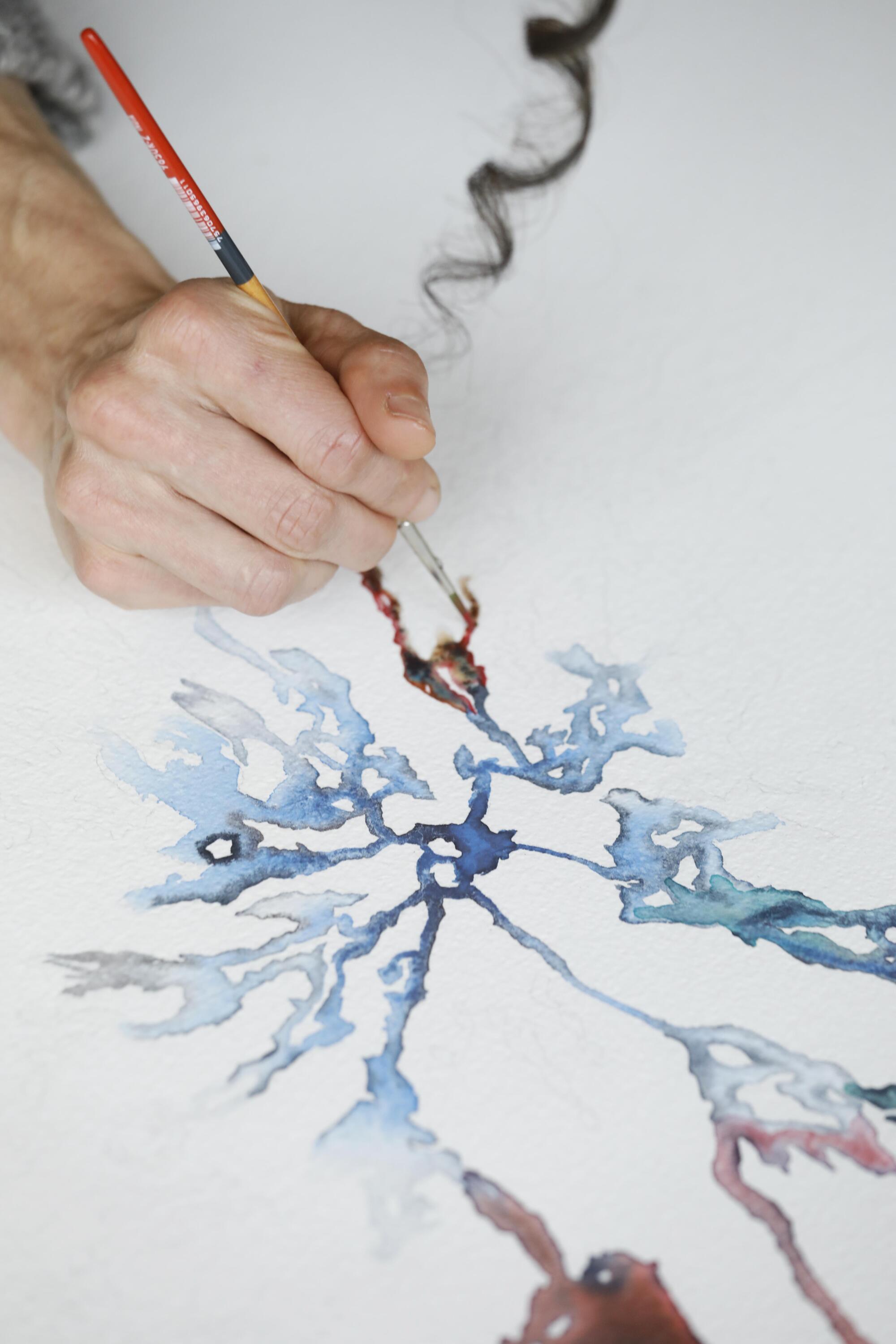
As she immersed herself in these muddled geometries, Molnar, who is petite with curly black hair and a Bonnie Raitt streak of gray, began to tap into a turbid well of emotion. It is apparent by the third piece. Overlapping shapes bruise dark blue to black, and ragged crimson lines slash across the canvas.
“The project isn’t just a way to convey information,” she said. “It’s a way to confront grief.”
Grief is an unpleasant cocktail of emotions: sadness, anxiety, shame and helplessness, to name a few. Psychologists recognize it as a normal — even necessary — response to loss. And its growing prevalence is yet another impact of climate change.
Those on the front lines mourn the loss of homes burned by wildfires, landscapes altered by drought or melting ice, and traditions overturned by ecological upheaval.
Some grieve for lost futures, or for innocent animals that had the bad luck to exist at this particular moment in geologic time.
It can be an overpowering and ongoing source of pain, said Ashlee Cunsolo, who studies environmental change and mental health at the Labrador Institute of Memorial University in Canada.
Researchers and therapists say that grief linked to climate change is on the rise.
“The environmental grief of climate change is often described as grief without end,” she said.
Yet climate grief is often stigmatized — or simply not talked about at all.
“A lot of people will either say, ‘I have never told anyone this because I feel silly,’ ” Cunsolo said. “Or they would say, ‘I could never figure out why I was feeling this way. I never had language.’”
Even climate activists often encourage us to focus on solutions, not sadness, said Jennifer Atkinson, who teaches environmental humanities at the University of Washington in Bothell.
“There’s this whole part of the environmental community that’s the hope police,” she said.
Many fear that dwelling in such dark feelings could make people shut down. But avoiding them is no better, warns Rosemary Randall, an advisor to the Climate Psychology Alliance, a group of psychotherapists in the U.K. who specialize in addressing the mental health consequences of global warming.
Refusing to feel the emotional costs of climate change is just another insidious and socially sanctioned form of denial, she said — one rooted in the classic psychological defense of compartmentalization.
“There’s one part of yourself that knows perfectly well that climate change is happening and another part of yourself that really doesn’t let that penetrate,” she said. “It doesn’t really ever get into your heart.”
The split is reinforced by society’s tendency to see climate change as a scientific issue, rather than a cultural and political challenge that demands our full humanity — the kind more often explored and addressed through art.
It was unseasonably hot when Molnar began painting on her back porch in the summer of 2017. Temperatures in Portland topped 100 degrees and the water from the rain barrel seemed even more precious.
Molnar felt as though climate change was bearing down on her. And as she got lost in the process of creating, she experienced grief as a kaleidoscope of feelings.
While painting an extremely intricate piece — one composed of slivers of land lost or threatened by rising seas — she felt a surge of anxiety. Sometimes, she shut down completely, unable to work.
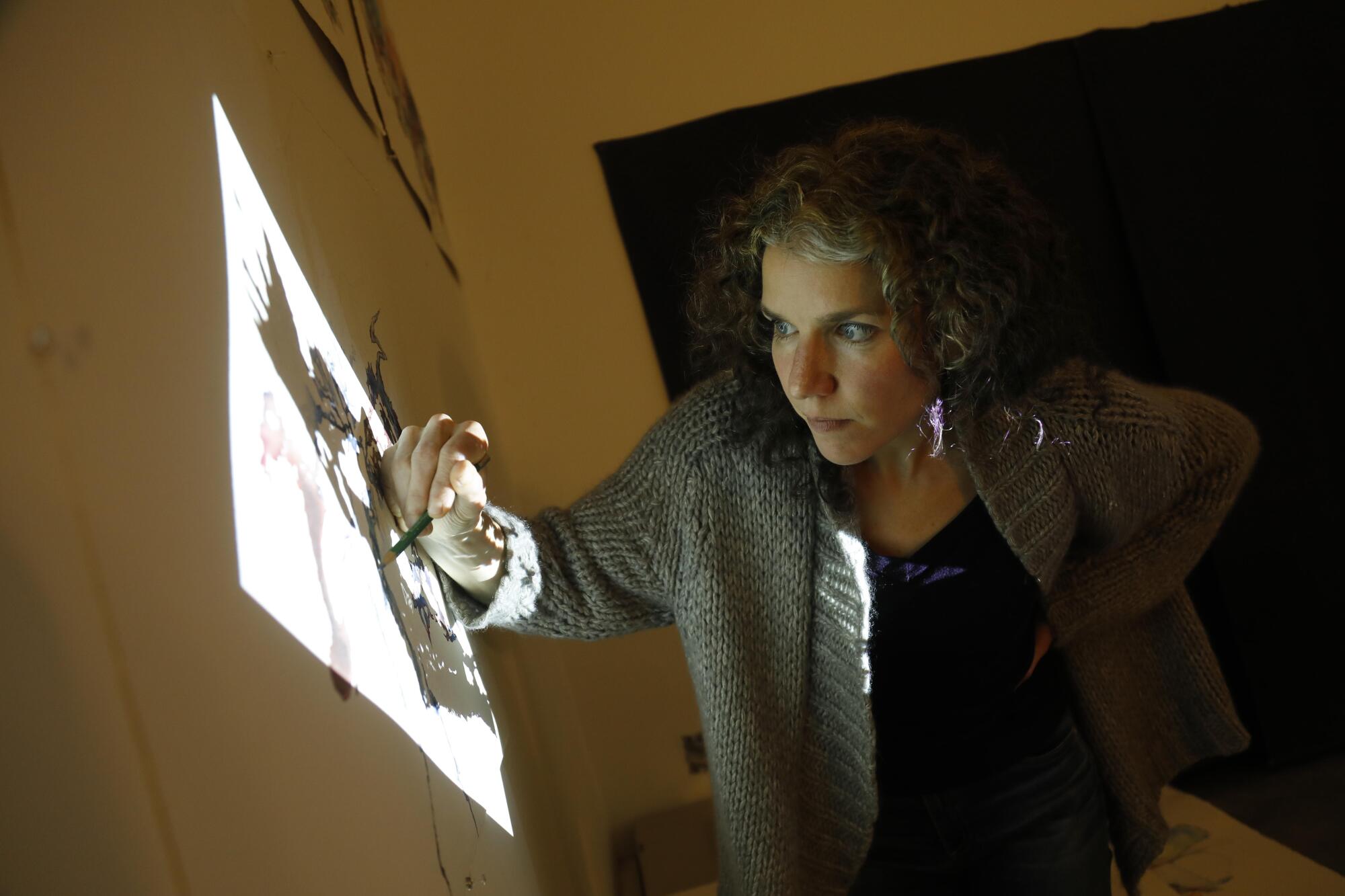
But in other moments, she found the emotions electrifying. “You are so awake in the grief that it’s almost a sublime experience,” she said.
Peter Kalmus, a climate scientist at a government laboratory, also has experienced the roller coaster of climate grief. He‘s been so overcome that he has broken down in tears — once at a public reading of his 2017 book about living more sustainably. “It took me completely by surprise,” he said.
He was reading a passage about his kids. “How strange it is to bring them to piano lessons and coach their soccer teams and sort of generally pretend that everything is fine when you know it isn’t,” he said.
But he is also grateful for the emotion. “I feel like grief unlocks the potential for action,” Kalmus said. “It’s a form of accepting reality.”
These stories make sense to Randall.
Instead of the popular five-stage model of grief that implies a linear progression from denial to acceptance, she thinks of grieving the way it’s been described by J. William Worden, of the Rosemead School of Psychology in La Mirada.
Grief, Worden said, is an ongoing set of tasks — like making space for uncomfortable feelings and adjusting to a new reality — that can be embraced or ignored.
The goal, after all, isn’t to “fix” grief. It’s to learn to live with loss.
“When somebody dies, you don’t stop remembering them or missing them. You create a way forward which has meaning,” Randall said.
If you don’t, she said, “you end up withdrawn, embittered, resentful, and inactive.”
And though some may mock it, grief can also be a powerful tool.
Cunsolo points to the moment when the representative from the South Pacific island nation of Tuvalu choked back tears while pleading for climate action at a 2009 U.N. meeting in Copenhagen. “The fate of my country rests in your hands,” he said in a quavering voice.
“That changed the climate discussion forever,” Cunsolo said. It made people realize that “this is not a technological issue, this is not an infrastructure issue. This is a human pain issue.”
Molnar has now made 14 paintings in her New Earth series — each one bright and beautiful and hopelessly complicated.
And she admits she still has not made peace with the losses they depict.
“I kind of thought I would come out feeling like, ‘got it!’” she said, sitting on a stool in her studio, with pale light falling through the door and her cat Stir Fry purring at her feet.
Instead, she said, “I ended up in a much more confused space, which is a space I’m still in. But it is a more honest space.”
Molnar’s perspective on climate change has shifted too. She doesn’t sweat the little things as much — like which produce to buy at the grocery store and whether it’s sustainable.
It matters, yes, but it can become an energy drain. “It becomes something you are focusing on when you should be focusing much larger.”
For her, the larger questions are: Can we reimagine a way to be human that doesn’t cause so much suffering for others? And how do we make space for the hard conversations, individually and collectively?
This, Randall said, is what it ultimately means to grieve climate change. The world is transforming, and we must all reimagine ourselves in it.
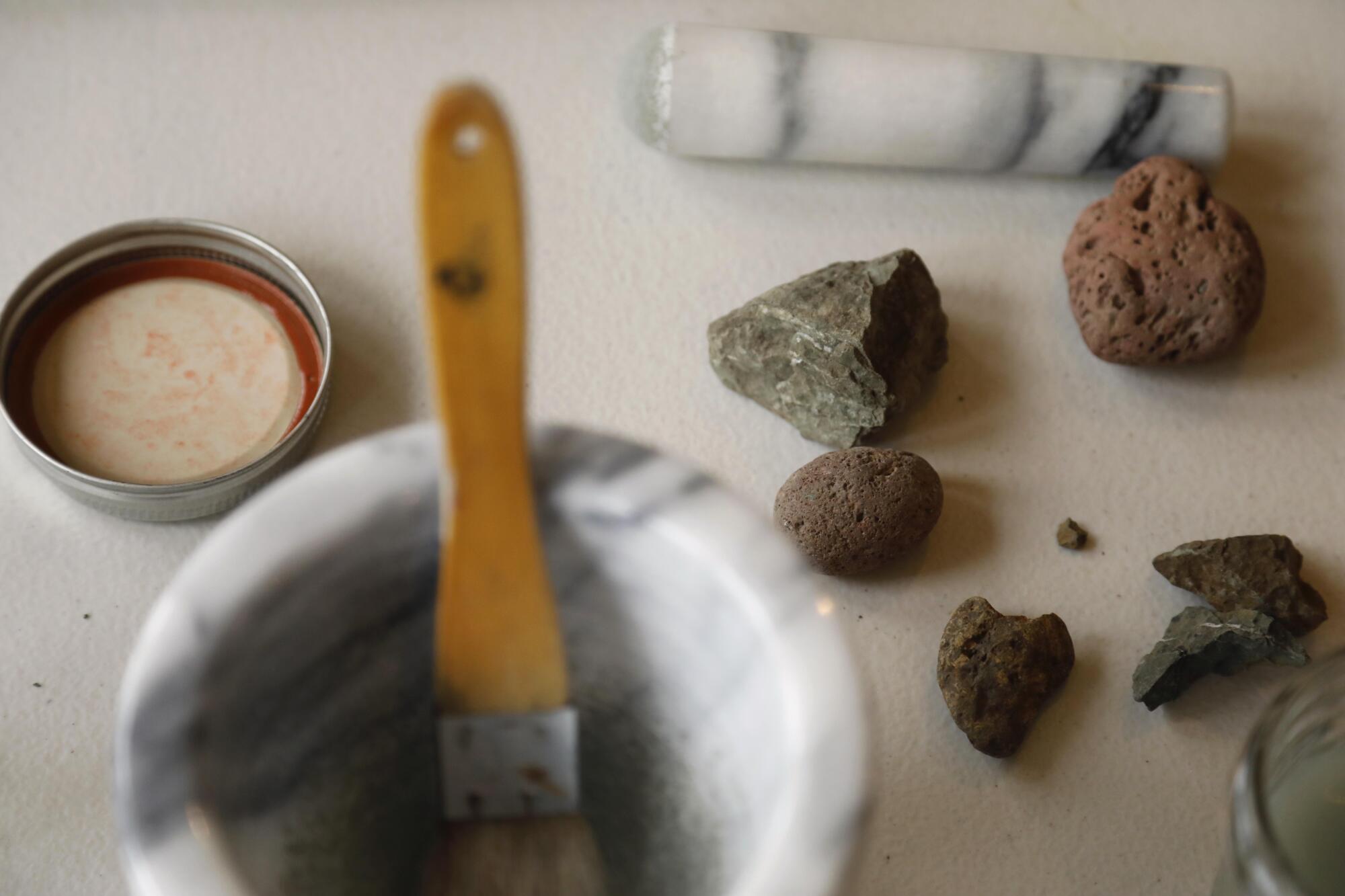
It won’t all be bad, Molnar said. “In my more hopeful moments, I understand climate change as an opportunity.”
Perhaps the prospect of environmental upheaval will prompt humanity to repair its relationship with nature — to experience a cultural shift that will allow us to grapple with the challenges before us, she said.
Molnar intends to keep working while she mulls these questions.
Her paintings have been praised by audiences and in art circles. She’s shown them in New York, Portland and Boise.
People are drawn in by the obvious aesthetic appeal of her pieces. “I made them that way so that we might be willing to feel the discomfort of confusion and grief a little longer,” she said. “To feel it, at least for a moment. To let it in.”
However, the work hasn’t sold well. Molnar suspects many people still aren’t ready to hang a painting about climate change on their wall, and to sit with what it really means.
